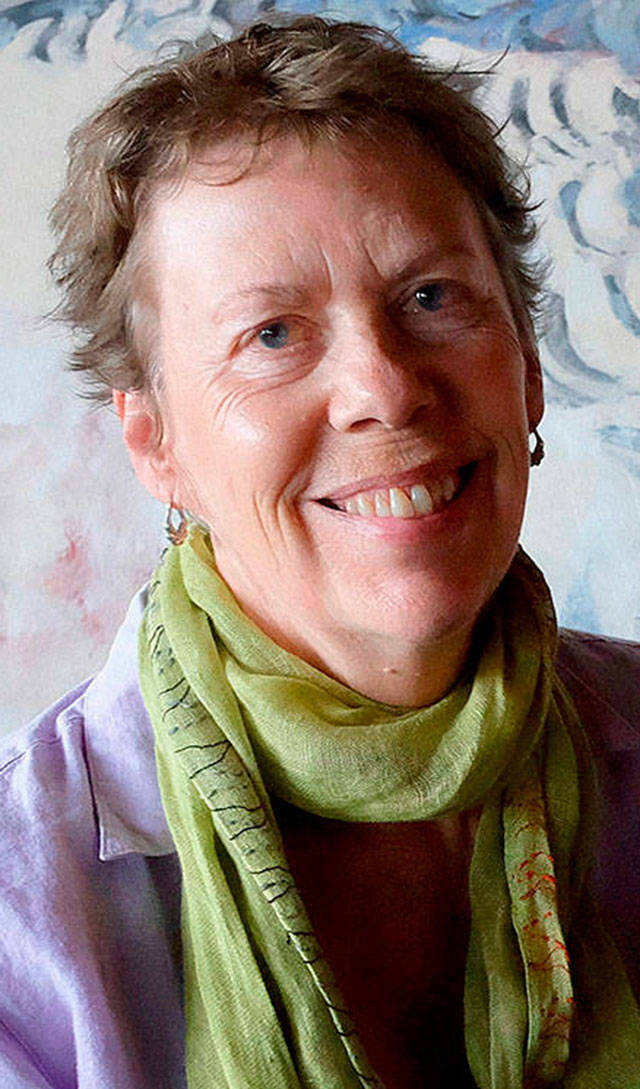Editor’s note: Green Briefs are a regular series of commentaries by eco-leaders on Vashon, presented in The Beachcomber in partnership with The Whole Vashon Project.
How to care about something you can’t even see? How about sparking the imagination with a good story?
About 33 years ago, on Mother’s Day, Vashon resident Karlista Rickerson was invited by two of her sons to join them and wade into the waters of Puget Sound down at Sandy Shores on Maury. They had already zipped her into a big, rubber diving suit, added a mask and a regulator and so, away they all went, down under. Thus began a lifelong passion. It was a night dive that really got her hooked, when she watched one son roll backward off a railing, entering black water that lit up his outline with diamonds.
Rickerson’s fascination with microscopic organisms really took off when she was underwater and saw a big ball of “something” amorphous coming her way. That actually happened often, with visibility pretty much wiped out if she didn’t swim sideways first. “It was a big bolus of plankton,” she explains. “They come in waves.”
It wasn’t long before she was collecting water samples and putting them under a microscope, camera attached. A wonderful world manifested as she kept identifying a wealth of different organisms, with tongue-twisting names such as Coscinodiscus and Akashiwo sanguinea.
She came to know, over the years, a whole different reality that is also part of Vashon — vital, in fact, to human health and well-being — but mostly unknown and underappreciated.
Visualize the waters around Vashon teeming with microscopic plants — an incredibly vast field, in fact. The plants are called phytoplankton. Extend your imagination to oceans around the world: fields vibrant with life, photosynthesizing with the energy of the sun and making more oxygen than all of our tropical rain forests combined.
One of the organisms is called Prochlorococcus—500 can fit on the head of a pin. The planet’s smallest photosynthesizing machine — estimates are that it alone generates 5% of the oxygen we breathe. Production of oxygen estimates from all plankton is around 50-70%. No plankton, no us.
What grazes on these microscopic plants? Microscopic “animals”— and some not so tiny as well, such as fish eggs, jellyfish, crustaceans and mollusks. These are the zooplankton, and on up the food chain, larger organisms progressively feeding and thriving to breed and reproduce.
And thus: no plankton, no whales.
When I asked Rickerson how things look in Vashon’s underwater neighborhood these days, her answer was, “not good.” On the west side of Vashon, the big kelp beds have disappeared. Back in 2008, a water sample under the microscope was overcrowded with organisms with tremendous variation. Today: one species.
“What happened to everything else?” she wondered.
“What upsets me,” said Rickerson, “is that everyone is agitating about saving the salmon and the orca. But if you don’t focus on the very basis of the entire aquatic food chain, you’re not going to get anywhere!”
According to the Washington State Puget Sound information website (vitalsigns.pugetsoundinfo.wa.gov), waters in the sound have been continually deteriorating over the past 20 years. They are warmer, more acidic and polluted; there is a decline in phytoplankton and thus, a decline in numbers of fish. Discharges from wastewater treatment plants and industries, plus erosion and stormwater runoff are major factors. Two modern Catch-22s are also major threats: pharmaceuticals and personal care products dissolved in sewage and fire retardant in runoff from forest fires.
There is the naïve mindset, “Flush and it’s gone.” It is not, because we are talking about living systems. Bottom line: many substances used by humans impact the life of our waters, even down to the microscopic level.
But what can our small community do? We can collect the right data and take the results seriously, for starters.
Tag Gornall, a retired marine mammal veterinarian, has the dream to make Vashon an epicenter of plankton awareness. The more we are able to “see” and understand what we need to treasure, the greater chance there will be positive action to stringently monitor and mitigate harm in everything that enters our local waters.
With a stretch of imagination, education, inspiration, and science, we can create a different end to this story.
Be sure not to miss Rickerson’s huge, colorful, plankton photographs at Puget Sound Cooperative Credit Union (PSCCU) in September and October, plus a painting of the aquatic web of life by Mexican artist Hodari Nundu, mounted on a “plankton fabric” designed by Gornall.
Coming in October to Vashon Center for the Arts: extraordinary, three-dimensional sculptures of plankton, created by Port Townshend artist Rebecca Welti.
Rondi Lightmark is the founder of The Whole Vashon Project. Visit The Whole Vashon Project’s YouTube channel to see a video about plankton.



